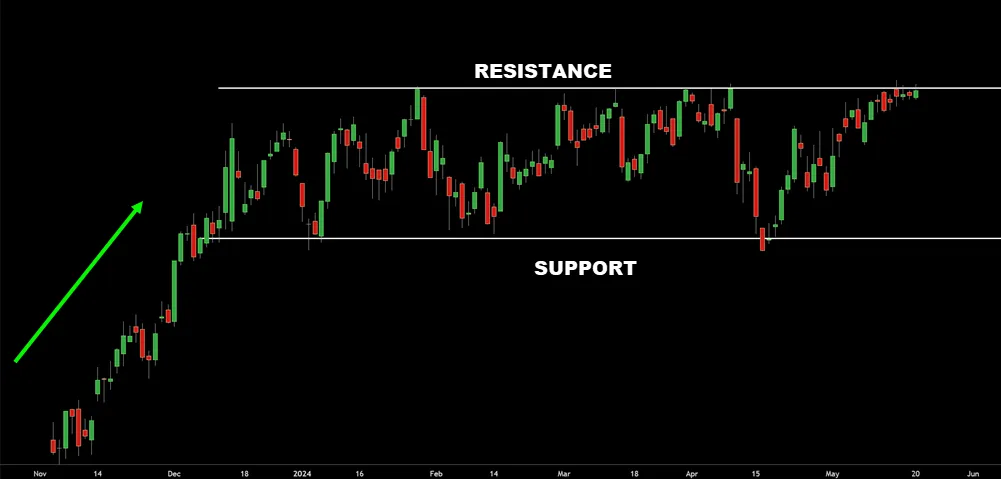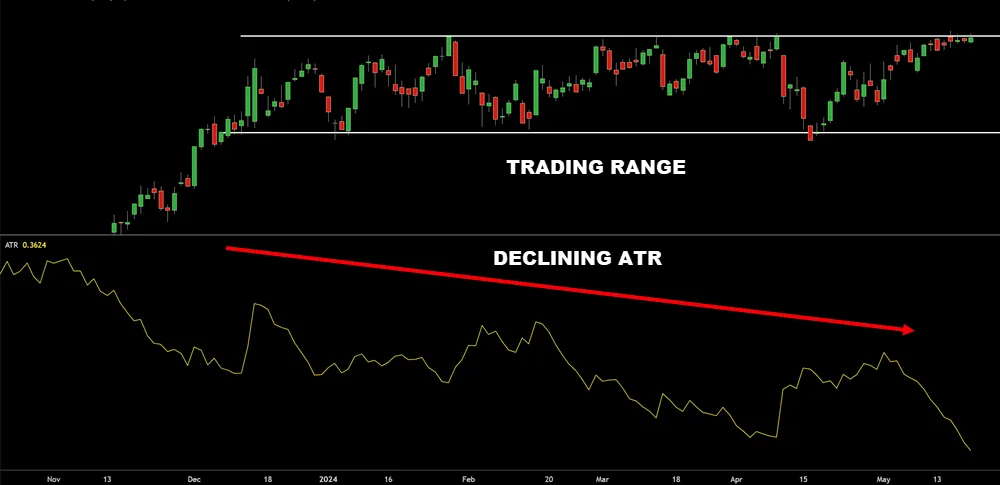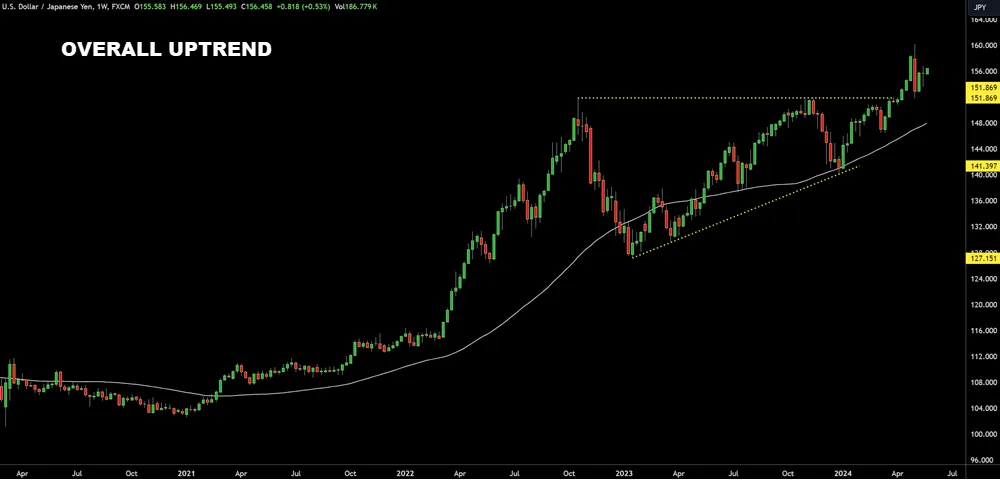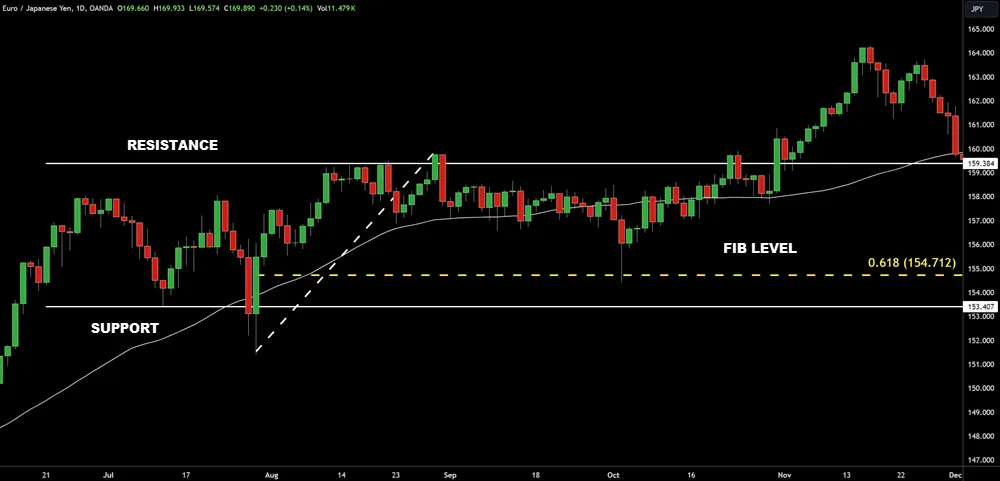Predicting Forex market consolidation involves analyzing support and resistance levels, observing candlestick patterns, and monitoring volume fluctuations (FX Futures). Breakouts or breakdowns around key levels often signal potential consolidation phases.

Combining technical and fundamental analysis, along with an understanding of market sentiment, aids in making informed trading decisions during consolidation periods. By mastering consolidation patterns, traders can learn to handle market choppiness and find good trading opportunities.
Main Points
- Analyze key support and resistance levels for consolidation zones.
- Watch for candlestick patterns indicating potential consolidation.
- Consider volume analysis to confirm market indecision.
- Look for breakouts or breakdowns around significant levels.
- Monitor the economic calendar for impactful news triggering consolidation.
What is Consolidation?
Consolidation in the forex market refers to a period of relative stability where prices move within a defined range. It is characterized by lower volatility and a lack of clear trend direction.
Distinguishing between consolidation and trending markets is essential for traders to make decisions based on market conditions.
Characteristics of Consolidation
Defined as a period of price movement where the asset’s value remains within a defined range, consolidation in the forex market is characterized by a lack of clear trend direction. During consolidation, price movements exhibit a sideways or range-bound pattern, with support and resistance levels containing currency fluctuations.
Market behavior in consolidation tends to be choppy, with frequent price reversals and limited follow-through on breakouts. Traders often use specific trading strategies designed to capitalize on the lack of trend momentum, such as range trading or mean reversion techniques.

Technical analysis plays a huge role in identifying consolidation patterns, as indicators like Bollinger Bands or the Average True Range can help pinpoint periods of low volatility.
Effective risk management becomes paramount during consolidation phases, as the absence of a clear trend can lead to increased false signals and whipsaw movements. Traders must adjust their risk exposure, setting tight stop-loss orders and being cautious of overleveraging positions.
Consolidation vs. Trending Markets
Differentiating between consolidation and trending market conditions is a must for traders looking to optimize their strategies and capitalize on any trading opportunity.
Trending markets exhibit a clear directional bias, with prices consistently making higher highs in an uptrend or lower lows in a downtrend.

Ranging markets, also known as consolidation phases, are characterized by sideways price movement within a defined range.
To differentiate between these market conditions, traders rely on price action analysis and market volatility indicators. Trading psychology plays a significant role in handling consolidation periods, as traders may experience increased frustration and impatience due to decreased trading opportunities.
| Trending Markets | Consolidation Markets |
|---|---|
| Clear directional bias | Sideways price movement |
| Higher highs in uptrend | Ranges within a defined range |
| Price action confirms trend | Higher highs in the uptrend |
| Volatility tends to be higher | Volatility decreases |
Causes of Consolidation
Forex market consolidation can be triggered by profit-taking combined with a sense of market indecision.
Additionally, a lack of significant catalysts or impactful news can contribute to a period of stagnation and consolidation in the market. The overall driver of FX is economic releases and interest rate differential.
Understanding these causes can assist traders in anticipating and trading through consolidation phases effectively.
Profit-Taking and Market Indecision
Market consolidation in forex often occurs due to a combination of profit-taking by traders and a general sense of indecision in the market.
Traders may choose to lock in profits during times of uncertainty or when price movements reach a level where the profit potential seems attractive. This profit-taking behavior can lead to a temporary equilibrium in the market, causing consolidation.

Trend analysis and identifying the best entry points become necessary during these periods. Traders utilizing technical analysis and monitoring price action can better gauge when profit-taking activities might trigger consolidation.
Effective risk management strategies and precise trade execution are key in handling such market conditions. Traders need to be mindful of market volatility and carefully time their trades to avoid getting caught in prolonged consolidation phases, ensuring they capitalize on profit-taking opportunities while managing risks effectively.
Lack of Catalysts and News
During periods of market consolidation in the forex market, a significant contributing factor often stems from the absence of catalysts and impactful news events driving price movements. When the market lacks new information or significant developments, traders may find it challenging to identify clear trends or opportunities for profitable trades.

This lack of catalysts can lead to a decrease in trading volume, resulting in price ranges tightening and creating a consolidation phase. During these times, traders need to adapt their strategies from trend-following to range trading-based strategies.
The table below highlights key considerations and actions that traders can implement to manage their positions effectively during periods of consolidation:
| Key Area | Action | Importance |
|---|---|---|
| Trading strategies | Adjust to range-bound strategies | Helps optimize entry and exit points |
| Price action | Monitor for smaller price movements | Indicates potential breakouts or breakdowns |
| Technical analysis | Focus on support and resistance levels | Identifies consolidation boundaries |
| Market psychology | Stay patient and avoid impulsive trades | Helps maintain discipline |
| Risk management | Tighten stop-loss levels | Minimizes potential losses |
Identifying Consolidation Patterns
Identifying consolidation patterns in the forex market involves analyzing various factors such as support and resistance levels, candlestick patterns, chart formations, and volume analysis (FX Futures). These indicators provide valuable insights into the potential areas where prices may consolidate before making the next significant move.
Support and Resistance Levels
The identification of key support and resistance levels plays a role in recognizing consolidation patterns within the market. Support levels indicate a price point where a downtrend could potentially reverse, while resistance levels signify a point where an uptrend may stall or reverse.

These levels are not arbitrary; they are based on a combination of factors including trend reversal signals, price action analysis, Fibonacci levels, moving averages, and market psychology.
Traders often observe how the price reacts around these levels to gauge market sentiment. A break above a resistance level could indicate a bullish trend, while a breach of a support level might signal a bearish sentiment.
Additionally, when the price consolidates within a range bounded by support and resistance levels, it suggests indecision in the market. Understanding these key levels can help traders anticipate potential breakout or breakdown scenarios during consolidation phases, enabling them to make trading decisions based on price dynamics and market psychology.
Candlestick Patterns and Chart Formations
Various candlestick patterns and chart formations provide traders with valuable tools for identifying consolidation patterns in the Forex market. Candlestick analysis is particularly useful in recognizing reversal signals during consolidation phases. Patterns like Doji, Hammer, and Shooting Star can indicate potential market indecision and upcoming price reversals.

Similarly, chart formations such as triangles, flags, and pennants are continuation patterns that suggest a temporary pause in the prevailing trend before resuming. By studying price action, traders can better understand market sentiment and identify key levels where consolidation is likely to occur.
Along with candlestick patterns and chart formations, technical indicators play an important role in confirming trends during consolidation. Using tools like moving averages, Relative Strength Index (RSI), and MACD can provide additional insights into the strength of a trend and potential breakout points.
Trading Strategies for Consolidation
When dealing with periods of market consolidation in the forex market, traders can use various strategies to capitalize on the range-bound nature of prices. Range-bound trading involves identifying key support and resistance levels to execute buy and sell orders within the established range.
Breakout trading, on the other hand, focuses on profiting from price movements that breach the consolidation boundaries. Implementing effective risk management techniques is essential to protecting your capital and optimizing trading performance during consolidation phases.
Range-Bound Trading
An effective trading strategy for maneuvering through market consolidation periods is using range-bound trading techniques to capitalize on price movements within a defined price range.
In range-bound markets, where prices fluctuate within a specific range without establishing a clear trend, traders can utilize various trading strategies to profit from these conditions. Price action analysis becomes essential in range-bound trading, focusing on how prices react at key levels within the range.

Technical analysis tools such as support and resistance levels, moving averages, and oscillators can aid in identifying potential entry and exit points.
Understanding market psychology is also important in range-bound trading. Traders need to recognize when the market is ranging and avoid getting caught in false breakouts or breakdowns.
Maintaining discipline, patience, and risk management are essential when implementing range-bound trading strategies. By adapting to the market’s current state and using appropriate trading techniques, traders can trade through range-bound markets effectively and take advantage of price movements within the established range.
Breakout Trading
Breakout trading during consolidation periods involves identifying key price levels where a significant price movement is anticipated. This strategy looks to capitalize on the potential breakout of a price range, leading to a strong trend in either direction.

Here are some essential aspects to keep in mind when implementing breakout strategies:
- Price Action: Analyzing the price movements within the consolidation phase can provide valuable insights into potential breakout levels. Understanding how prices behave near support and resistance zones is essential for identifying breakout opportunities.
- Technical Analysis: Utilizing technical indicators such as moving averages, Bollinger Bands, and Fibonacci retracements can help traders pinpoint potential breakout points. Combining these tools with chart patterns like triangles or rectangles can enhance the accuracy of breakout predictions.
- Market Psychology: Recognizing market sentiment and understanding how traders react to price movements during consolidation can aid in anticipating breakouts. Traders should be mindful of sudden shifts in sentiment that could trigger significant price movements.
Implementing effective risk management strategies is paramount when engaging in breakout trading to mitigate potential losses and protect capital during volatile market conditions.
Risk Management Techniques
Robust risk management techniques are essential for traders dealing with consolidation phases in the forex market to safeguard their investments and optimize trading outcomes. Risk assessment plays an important role in identifying potential risks associated with market consolidation, allowing traders to decide whether or not to take the trade.
Position sizing is another aspect, determining the amount of capital to allocate per trade relative to the account size, and reducing the impact of losses during volatile periods. Implementing stop losses is necessary to limit potential losses and protect profits, especially in choppy market conditions characteristic of consolidation phases.
A diversification strategy is key in spreading risk across different currencies to mitigate the impact of adverse movements in a single position. Considering market volatility is also important when setting risk management parameters, as heightened volatility during consolidation can increase the likelihood of sudden price swings.
Predicting Consolidation Periods
When predicting consolidation periods in the forex market, it is essential to pay close attention to major support and resistance levels. These key levels often act as barriers that the price must overcome before entering a new trend or continuing its current direction.
Additionally, monitoring the economic calendar and upcoming news events can provide insights into potential periods of market consolidation.
Major Support and Resistance Levels
The identification and analysis of major support and resistance levels play a significant role in predicting consolidation periods within the Forex market. Understanding these key levels is essential for traders as they provide insights into potential price action and market behavior.

Here are three essential aspects to take into account:
- Price Action: Major support and resistance levels often reflect significant price points where a high concentration of buy or sell orders are located. Observing how price behaves around these levels can offer valuable clues about market sentiment and potential future price movements.
- Trend Reversal: When price approaches a major support or resistance level, it can act as a turning point for the market trend. Traders use these levels to anticipate potential trend reversals and adjust their trading strategies accordingly.
- Market Psychology: Support and resistance levels are not just numerical points on a chart; they represent the collective psychology of market participants. Understanding the psychological dynamics at play around these levels can help traders make more informed decisions based on market sentiment.
Economic Calendar and News Events
Analysis of the economic calendar and upcoming news events is essential in predicting consolidation periods in the Forex market. By combining technical analysis, fundamental analysis, market sentiment, trading psychology, and risk assessment, traders can make decisions based on the potential impact of economic indicators and news releases on currency pairs.
Reacting to significant events without a proper understanding can lead to increased market volatility and potential consolidation phases.
| Category | Importance |
|---|---|
| Technical Analysis | High |
| Fundamental Analysis | High |
| Market Sentiment | Medium |
| Trading Psychology | Medium |
Technical analysis helps identify key levels where consolidation may occur, while fundamental analysis provides insight into how economic events can trigger market reactions. Market sentiment and trading psychology play a critical role in understanding how traders interpret news events, influencing market behavior. Effective risk assessment is essential to manage potential consolidation risks during volatile periods driven by economic news. By integrating these factors, traders can navigate consolidation phases more effectively in the Forex market.
Mastering Consolidation in Forex Trading
Understanding the details of identifying and maneuvering through consolidation patterns is essential for achieving success in Forex trading.
When mastering consolidation in Forex trading, several factors come into play:
- Entry Signals: Utilizing entry signals such as breakouts or bounces within consolidation zones can help traders enter positions at ideal points.
- Price Action: Analyzing price action within consolidation patterns can provide valuable insights into potential market direction and momentum.
- Market Psychology: Understanding the behavior of market participants during consolidation phases is vital for making informed trading decisions.
Developing a Consolidation Trading Plan
Crafting a strategic consolidation trading plan involves attention to market dynamics and execution to capitalize on potential opportunities. When developing a plan for trading during consolidation phases in the forex market, several key elements need to be considered.
| Aspect | Description |
|---|---|
| Entry Points | Identifying suitable entry points based on price action analysis. Understanding how prices move within a consolidation range can help traders pinpoint excellent entry levels. |
| Risk Management | Effective risk management strategies are essential to protect capital during uncertain market conditions. Setting stop-loss orders and determining position sizes carefully can mitigate potential losses. |
| Market Psychology | Being aware of market psychology is vital when trading consolidations. Traders need to gauge sentiment and market participants’ behavior to make informed decisions. |
| Trade Execution | Trade execution plays a significant role in the success of a consolidation trading plan. Timely and accurate execution of trades is crucial to capturing profits within the consolidation range. |
Frequently Asked Questions
How Does Market Sentiment Influence Forex Consolidation?
Market sentiment influences forex consolidation through sentiment analysis, economic indicators, technical analysis, market psychology, and trading strategies. Understanding these factors provides insights into how traders perceive market conditions and make decisions, influencing consolidation patterns.
Can Geopolitical Events Affect Forex Market Consolidation?
Geopolitical events can greatly impact forex market consolidation. Political uncertainty, global conflicts, trade agreements, and economic indicators influence market sentiment. Changes in interest rates due to geopolitical factors can trigger market shifts, leading to consolidation patterns.
Is There a Correlation Between Volume and Consolidation Periods?
Analyzing volume correlation during consolidation periods provides valuable insights into market sentiment. Geopolitical impacts can amplify these patterns, influencing timeframe fluctuations. Central bank actions further shape these trends, making a thorough analysis essential for informed decision-making.
How Do Central Bank Policies Impact Forex Market Consolidation?
Central bank policies play a pivotal role in shaping forex market dynamics. Through interest rate decisions, quantitative easing measures, and forward guidance, central banks can influence market sentiment, and liquidity, and ultimately impact the occurrence and extent of market consolidation.
Conclusion
Mastering the prediction of forex market consolidation is essential for successful trading.
By understanding the causes of consolidation, identifying patterns, and implementing appropriate trading strategies, traders can capitalize on these periods of price stability.
Developing a solid consolidation trading plan based on data and analysis will help traders navigate the forex market with confidence and efficiency.
